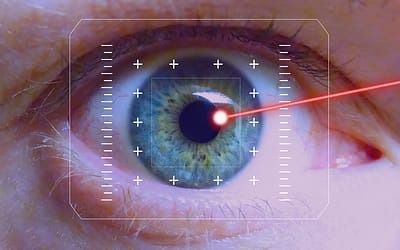
Glaucoma is a progressive eye condition that involves abnormally high eye pressure and can lead to vision loss and nerve damage in the eyes. Historically, the treatment options for glaucoma have been topical eye drops to lower the eye pressure or eye surgery that involved cutting open part of the iris to reduce the eye pressure. Newer treatment now includes an option of laser surgery that requires no actual incisions into the eye. Selective laser trabeculoplasty is a minimally invasive procedure that can be performed in the office and has the potential to greatly reduce eye pressure and treat glaucoma.
What is Glaucoma?
Glaucoma itself can be caused by many things but the unifying factor is that there is damage to the optic nerve in the back of the eye – usually from high eye pressure.
When the eye pressure is too high, it can cause excess pressure to be placed on the optic nerve and lead to damage to small nerve fibers which carry information.
As this occurs over a long period of time, the damage can accumulate and lead to loss of peripheral vision that progresses to loss of central vision without intervention.
What Treatment Options are available for Glaucoma?
To treat glaucoma, the eye pressure is lowered using either eye drops and medication or surgery.
When the eye pressure is lowered, the risk of additional damage and loss of vision is reduced.
Eye drops to lower eye pressure are usually the first treatment option as there is little risk and the drops are relatively inexpensive.
If eye drops are unsuccessful, surgery treatment may be indicated. This can either be a laser surgery or a true incisional surgery of the eye.
Laser Surgery for Glaucoma
The most common laser surgery used in glaucoma treatment is known as selective laser trabeculoplasty.
This laser surgery uses a green light laser to open the drainage system in the front of the eye by creating inflammation that triggers cells to remove the debris.
Selective laser trabeculoplasty does not require any cutting into the eye and only needs topical anesthetic for a contact lens that is used during the procedure.
Recovery from Selective Laser Trabeculoplasty
Selective laser trabeculoplasty (SLT) usually causes minimal pain during and after the procedure.
The inflammation created may lead to red eyes, mild light sensitivity, and blurred vision in the hours after the procedure. These are normal reactions to the laser and are not indicative of any problem or side effect.
Most of the time, the laser procedure will have its complete effect on lowering the eye pressure by four to six weeks and this is usually the next follow-up appointment.
Does the Eye Pressure Change After SLT?
After having an SLT, the eye pressure will likely be lowered by 25 to 30 percent. This is often enough that one glaucoma eye drop that was being used previously is no longer required.
However, it is important to continue using the eye drops until your doctor has instructed you to stop.
If the eye pressure increases over time, SLT can be repeated. When SLT is repeated, the effect is slightly lower, and eye pressure may not decrease as much as on the initial treatment.
Our eye doctor at Local Eyes Optometry in New Braunfels, TX excels in the prescription of glasses, contact lenses and the diagnosis of a variety of eye diseases. Call our optometrist at (830) 627-9272 or schedule an eye exam appointment online if you would like to learn more about Selective Laser Trabeculoplasty (SLT). Our eye doctor, Dr. Marcus Page, provides the highest quality optometry services and eye exams in New Braunfels, Texas.








